Switches and Controls
Headlights
Turn the headlight switch to turn the headlights and other exterior lights on or off.
When the lights are turned on, the lights-on indicator light in the instrument cluster turns on.

-
If the light switch is left on, the lights will automatically switch off approximately 30 seconds after switching the ignition off.
The time setting can be changed.
Refer to Personalization Features (Search).
-
To prevent discharging the battery, do not leave the lights on while the engine is off unless safety requires them.
Without auto-light control

|
Switch Position |
 |
 |
 |
|||
|---|---|---|---|---|---|---|
|
Ignition Position |
ON |
ACC or OFF |
ON |
ACC or OFF |
ON |
ACC or OFF |
|
Headlights |
Off |
Off |
Off |
Off |
On |
On*2 |
|
Daytime running lights |
On*1 |
Off |
On*1 |
Off |
Off |
Off |
|
Taillights Parking lights License plate lights Side-marker lights |
Off |
Off |
On |
On*2 |
On |
On*2 |
-
The lights are turned on while the vehicle is driven.
-
The lights are turned on for the specified period by the auto headlight off function.
With auto-light control


|
Switch Position |
 |
 |
 |
 |
||||
|---|---|---|---|---|---|---|---|---|
|
Ignition Position |
ON |
ACC or OFF |
ON |
ACC or OFF |
ON |
ACC or OFF |
ON |
ACC or OFF |
|
Headlights |
Off |
Off |
Auto*2 |
Auto*4 |
Off |
Off |
On |
On*5 |
|
Daytime running lights |
On*1 |
Off |
On*3 |
Off |
On*1 |
Off |
Off |
Off |
|
Taillights Parking lights License plate lights Side-marker lights |
Off |
Off |
Auto*2 |
Auto*4 |
On |
On*5 |
On |
On*5 |
-
The lights are turned on while the vehicle is driven.
-
The lights are turned on by the auto light function.
-
The lights are turned on while the vehicle is driven, and turned off when the headlights are turned on by the auto light function.
-
The lights are turned on continuously if the ignition is switched from ON to any other position with the lights turned on. The lights are turned on for the specified period by the auto headlight off function.
-
The lights are turned on for the specified period by the auto headlight off function.
Auto-light control (Some Models)
When the headlight switch is in the  position and the ignition is switched ON, the light sensor senses the surrounding lightness or darkness and automatically turns the headlights and other exterior lights on or off.
position and the ignition is switched ON, the light sensor senses the surrounding lightness or darkness and automatically turns the headlights and other exterior lights on or off.
-
Do not shade the light sensor by adhering a sticker or a label on the windshield. Otherwise the light sensor will not operate correctly.

-
The light sensor also works as a rain sensor for the auto-wiper control. Keep hands and scrapers clear of the windshield when the wiper lever is in the
 position and the ignition is switched ON as fingers could be pinched or the wipers and wiper blades could be damaged when the wipers activate automatically. If you are going to clean the windshield, be sure the wipers are turned off completely when it is particularly tempting to leave the engine running. This is particularly important when clearing ice and snow.
position and the ignition is switched ON as fingers could be pinched or the wipers and wiper blades could be damaged when the wipers activate automatically. If you are going to clean the windshield, be sure the wipers are turned off completely when it is particularly tempting to leave the engine running. This is particularly important when clearing ice and snow.
-
The headlights and other exterior lights may not turn off immediately even if the surrounding area becomes well-lit because the light sensor determines that it is night time if the surrounding area is continuously dark for several minutes such as inside long tunnels, traffic jams inside tunnels, or in indoor parking lots.
In this case, the lights turn off if the light switch is turned to the
 position.
position. -
The sensitivity of the auto-light control may be changed.
Refer to Personalization Features (Search).
Headlight Leveling (Some Models)
The number of passengers and weight of cargo in the luggage compartment change the angle of the headlights.
The angle of the headlights will be automatically adjusted when turning on the headlights.
Daytime Running Lights
Some countries require moving vehicles to have their lights on (daytime running lights) during the daytime.
The daytime running lights turn on automatically when the vehicle starts moving.
They turn off when the parking brake is operated or the shift lever is shifted to the P position (automatic transaxle vehicle).
(Except Canada)
The daytime running lights can be deactivated.
Refer to Personalization Features (Search).
Turn and Lane-Change Signals
The ignition must be switched ON to use the turn and lane-change signals.
Windshield Wipers
Turn the wipers on by pressing the lever up or down.
With intermittent wiper
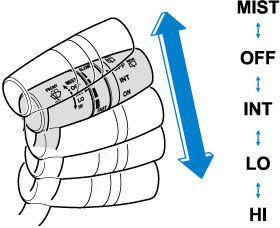
|
Switch Position |
Wiper operation |
|---|---|
 |
Operation while pulling up lever |
 |
Stop |
 |
Intermittent |
 |
Low speed |
 |
High speed |
Variable-speed intermittent wipers
Set the lever to the intermittent position and choose the interval timing by rotating the ring.
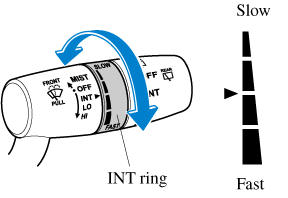
With auto-wiper control
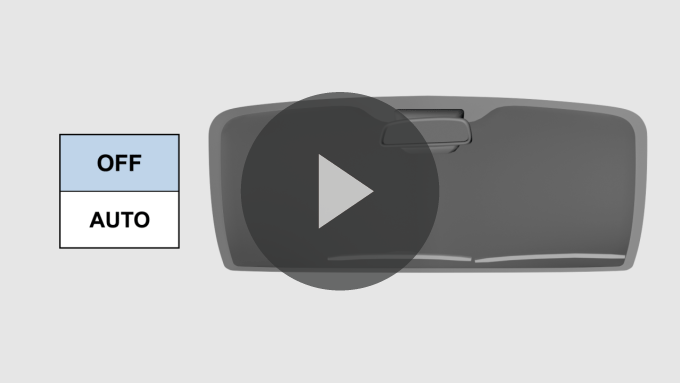
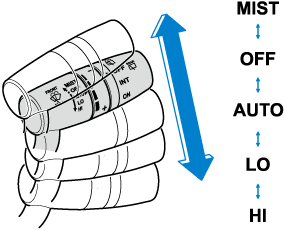
|
Switch Position |
Wiper operation |
|---|---|
 |
Operation while pulling up lever |
 |
Stop |
 |
Auto control |
 |
Low speed |
 |
High speed |
Auto-wiper control
When the wiper lever is in the  position, the rain sensor senses the amount of rainfall on the windshield and turns the wipers on or off automatically (off―intermittent―low speed―high speed).
position, the rain sensor senses the amount of rainfall on the windshield and turns the wipers on or off automatically (off―intermittent―low speed―high speed).
The sensitivity of the rain sensor can be adjusted by turning the switch on the wiper lever.
From the center position (normal), rotate the switch upward for higher sensitivity (faster response) or rotate it downward for less sensitivity (slower response).
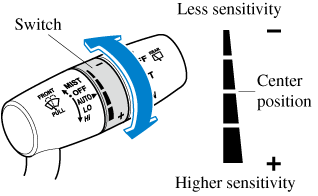
-
Do not shade the rain sensor by adhering a sticker or a label on the windshield. Otherwise the rain sensor will not operate correctly.

-
When the wiper lever is in the
 position and the ignition is switched ON, the wipers may move automatically in the following cases:
position and the ignition is switched ON, the wipers may move automatically in the following cases:-
If the windshield above the rain sensor is touched or wiped with a cloth.
-
If the windshield is struck with a hand or other object from either outside or inside the vehicle.
Keep hands and scrapers clear of the windshield when the wiper lever is in the
 position and the ignition is switched ON as fingers could be pinched or the wipers and wiper blades damaged when the wipers activate automatically.
position and the ignition is switched ON as fingers could be pinched or the wipers and wiper blades damaged when the wipers activate automatically.If you are going to clean the windshield, be sure the wipers are turned off completely (when it is most likely that the engine is left running) this is particularly important when clearing ice and snow.
-
-
Switching the auto-wiper lever from the
 to the
to the  position while driving activates the windshield wipers once, after which they operate according to the rainfall amount.
position while driving activates the windshield wipers once, after which they operate according to the rainfall amount. -
The auto-wiper control may not operate when the rain sensor temperature is about -10 °C (14 °F) or lower, or about 85 °C (185 °F) or higher.
-
If the windshield is coated with water repellent, the rain sensor may not be able to sense the amount of rainfall correctly and the auto-wiper control may not operate properly.
-
If dirt or foreign matter (such as ice or matter containing salt water) adheres to the windshield above the rain sensor, or if the windshield is iced, it could cause the wipers to move automatically. However, if the wipers cannot remove this ice, dirt or foreign matter, the auto-wiper control will stop operation. In this case, set the wiper lever to the low speed position or high speed position for manual operation, or remove the ice, dirt or foreign matter by hand to restore the auto-wiper operation.
-
If the auto-wiper lever is left in the
 position, the wipers could operate automatically from the effect of strong light sources, electromagnetic waves, or infrared light because the rain sensor uses an optical sensor. It is recommended that the auto-wiper lever be switched to the
position, the wipers could operate automatically from the effect of strong light sources, electromagnetic waves, or infrared light because the rain sensor uses an optical sensor. It is recommended that the auto-wiper lever be switched to the  position other than when driving the vehicle under rainy conditions.
position other than when driving the vehicle under rainy conditions. -
The auto-wiper control functions can be turned off. Refer to Personalization Features (Search).
Rear Window Wiper
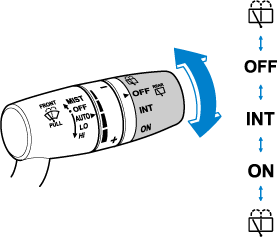
Turn the wiper on by turning the rear wiper/washer switch.
|
Switch Position |
Wiper operation |
|---|---|
 |
Stop |
 |
Intermittent |
 |
Normal |
Horn
To sound the horn, press the  mark on the steering wheel.
mark on the steering wheel.
Reprogramming the HomeLink system
To program a device to HomeLink using a HomeLink button previously trained, follow these steps:
-
Press and hold the desired HomeLink button. DO NOT release the button.
-
The indicator light will begin to flash after 20 seconds. Without releasing the HomeLink button, proceed with “Programming” - step 1.














































